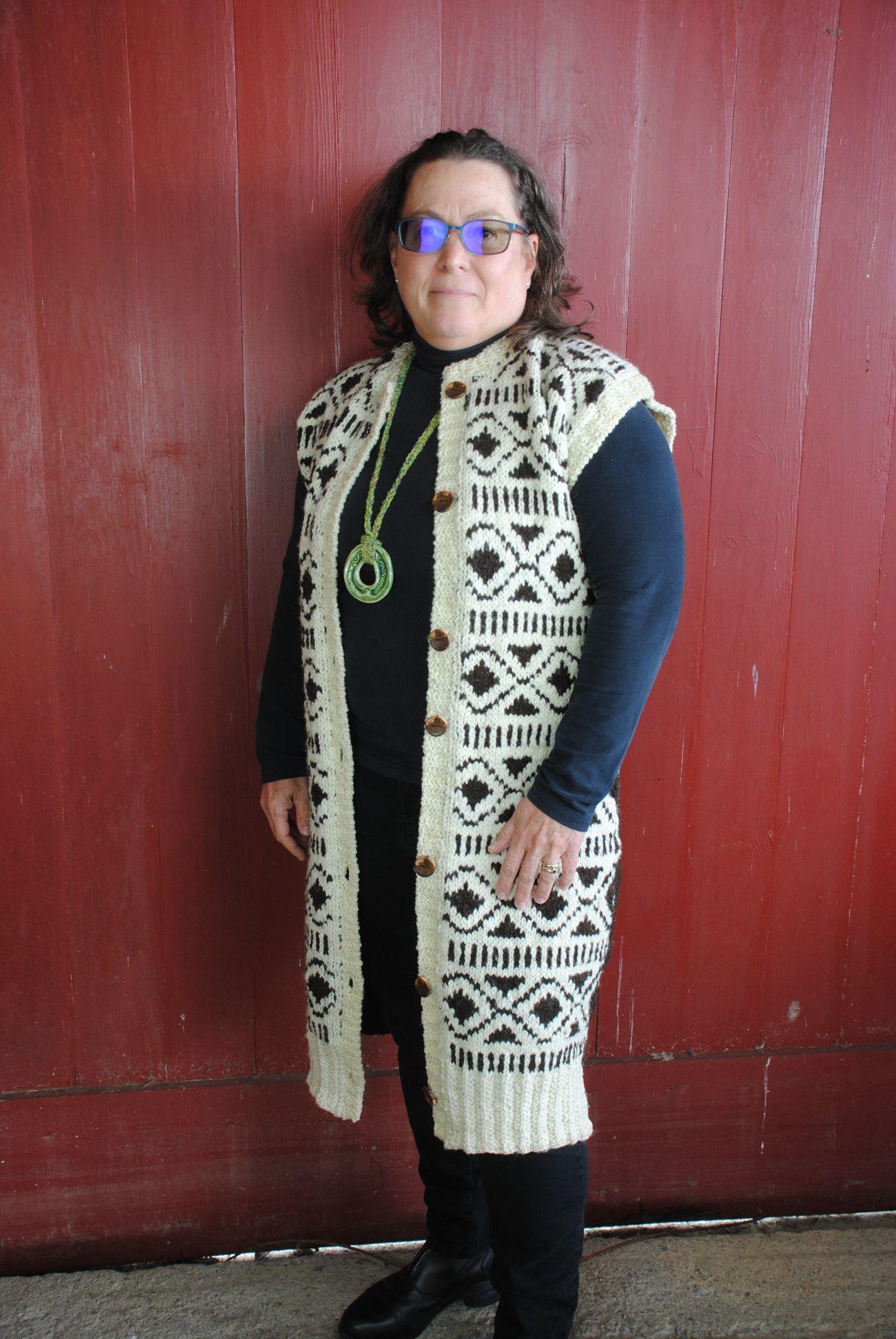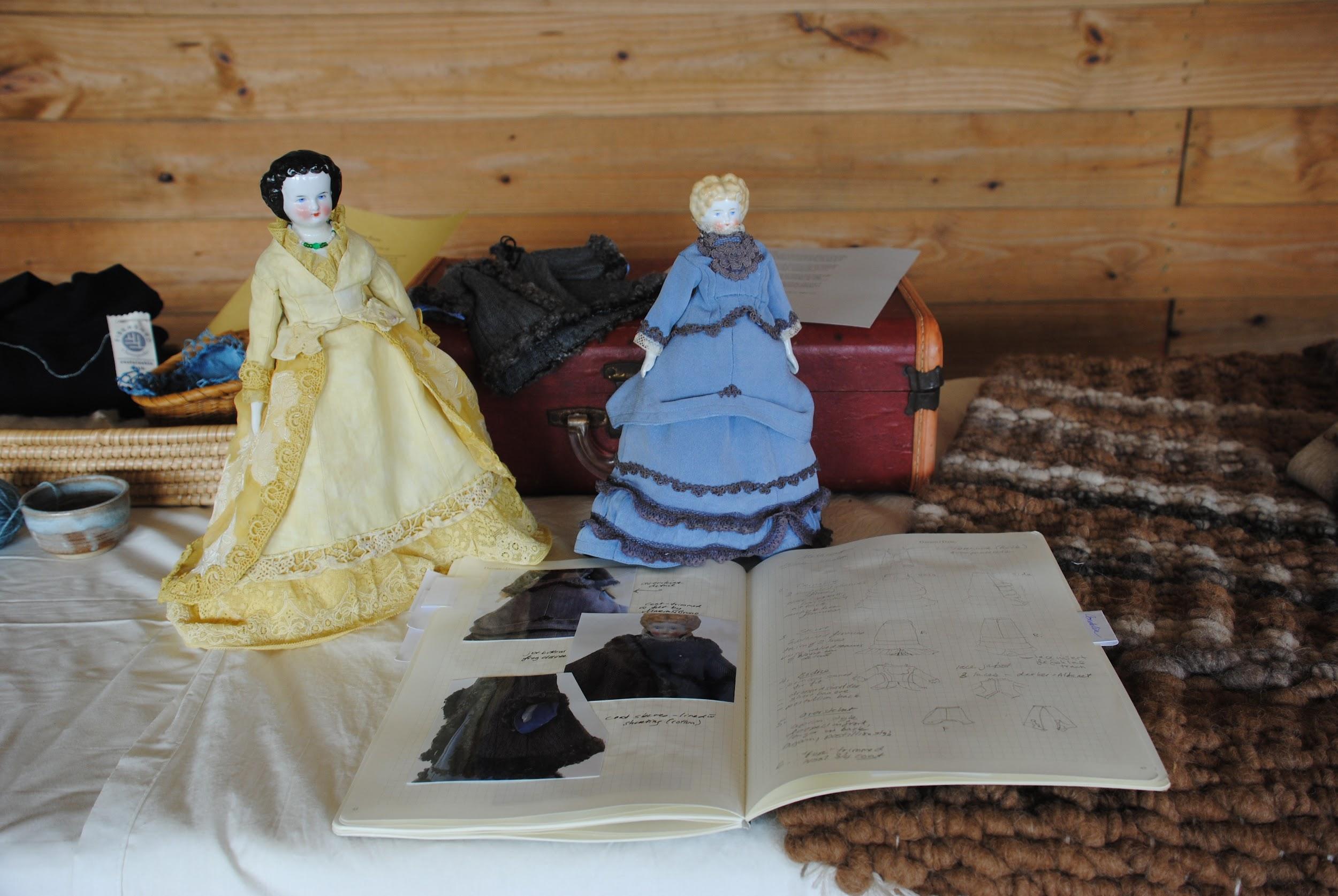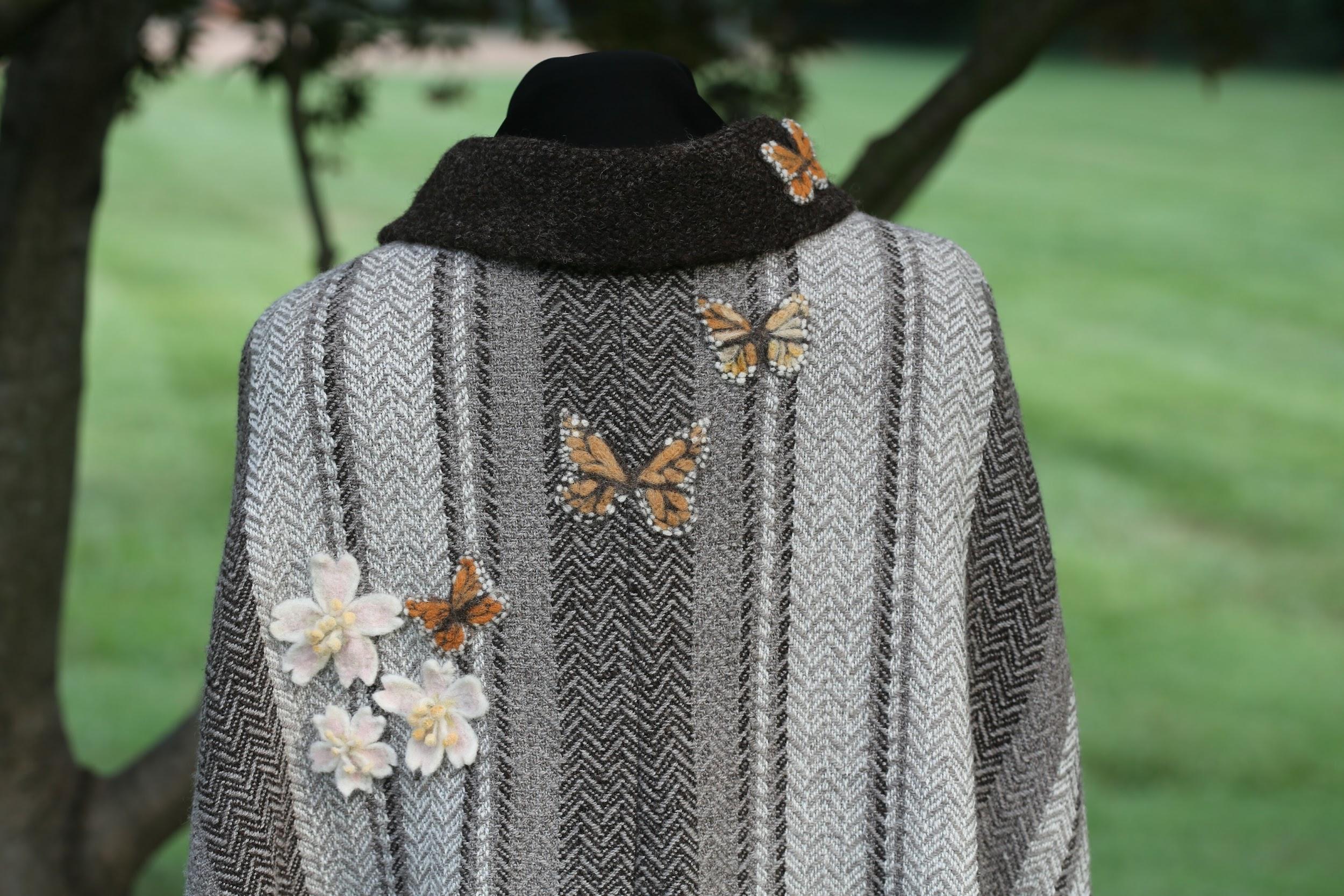
7 minute read
Youth Indigo Partnership
Devilsbliss Duster
Stream: Embracing
Advertisement
Fleece: East Friesian Fleece and Zwartbles Fleece from Devilsbliss Farm, Lovettesville, VA Buttons: wood from Chardonnay vines at Devilsbliss Farm, hand-made by local craftsman, Jeff Struwing of Takoma Park, Maryland 100% wool "gros-grain" ribbon from Burnley & Trowbridge, Williamsburg, Virginia
Since learning to spin in 2015, I have had a desire to spin as many different breeds to learn the distinctions and characteristics of different types of fiber. In 2019, I purchased, processed and spun my first Devilsbliss Zwartbles fleece; the following year I purchased one of their East Friesian fleeces.
Loving and even surprised by the results (East Friesian is known for its milk, not its wool), I sought to demonstrate to others that this particular family of sheep was worthy of being made into yarn. With a growing fondness for Tracy Kirkman, the shepherdess working so hard to raise these animals, I offered to knit Tracy a sweater of her choice. This offer coincided with the 2022 Sustainable Cloth Challenge. This was hand knit using a pattern I created.
Jillaine Smith
I've been a maker (with fiber) off and on since the late 1970s-- quilting, crocheting, knitting. I discovered my passion for spinning, then transforming raw wool into finished product starting in 2015. I had no idea when I started working with wool how many different breeds were out there and how different the results could be from different breeds. I continue to enjoy the discovery. I have grown increasingly interested in supporting breeders and shepherds who are practicing sustainable farming as I believe this practice is key to both addressing the challenge of climate change and establishing a healthy food system.

Victorian Fashion Dolls
Stream: Re-envisioning Vintage laces and linen or cotton small pieces (e.g., handkerchiefs, doilies, runners), collected through the years from estate sales and antique shops in the area: all dyed with weld or alkanet from my garden. Recycled silk blouse, wool suiting, cotton shirt - all from my family closets; "fur" trim for coat is felt from BFLlamb locks, made by Marian Bruno. The laces are dyed with alkanet. Both doll's underpinnings are made from vintage handkerchiefs and laces. Bustles and the channels in the crinoline are stuffed with local fleece -- a common practice to obtain volume before invention of the watch-spring steel 'cage crinoline' in 1856.
I never played with dolls as a child, but have long had an interest in sewing and historical fashion: one of my majors in college was Victorian Studies, and I used to make (human) costumes for a local Gilbert & Sullivan troupe. Somehow this all came together during the first Covid year, when I unearthed my grandmother's porcelain head doll and started making clothes for her. I set myself the task of making each outfit as historically accurate as possible for a given era of Queen Victoria's reign. Soon my grandmother's doll, Millicent, was joined by an eBay friend, Cordelia. Although both are close in height (10-11"), they are quite differently shaped, as 19th c. porcelain head dolls were not standardized. Porcelain head dolls were all the rage from about 1840-1920. Typically these dollswere made to look like grown women, with painted molded hair and face. The head is attached to a body made from fabric or leather, stuffed to give hips, bust and other figure elements. Often the arms and legs are also of painted porcelain and attached at elbow and knee, giving some flexibility, and giving each doll a unique body shape, just asa human.
For the Sustainable Cloth Challenge, I decided to use vintage and upcycled fabrics, dyed with plant dye that I made from my dye garden materials. Both dolls are styled in the late 1860’s fashion, which is the period when chemical dyes were first being introduced. I like to think that my ladies had enough fashion sense to eschew the violent new colors and stick with the classic natural palate , even while embracing the evolving silhouette, which involved a lot of underpinning and over-draping.
Mary Lou Steptoe
Washington DC native, with family roots in Virginia and Maine. Retired lawyer. Gardener, singer, lover of all things fiber, especially knitting and sewing.



A Joyful Storm of Raspberry Cape
Stream: Embracing
100% Corriedale Cross wool from Howell Hill
The “Joyful Storm of Raspberry Cape” is 100% wool from Howell Hill’s organically pastured and grain fed Corriedale cross sheep. Three natural-colored fleeces of cream, gray and chocolate set the tone for this mid-calf length cape. All wool was hand processed, spun, felted, and woven by a team assembled from the Weavers Guild of Greater Baltimore. Fabric for the cape body was floor-loom woven, while the collar fabric was rectangle-loom woven. The weave structure is a balanced broken twill with a sett of 16 ends per inch. Eye-pleasing symmetry in cloth design across the front and back also creates a stunning chevron at the shoulder side seams. Shell buttons secure the cape at the neckline. In an homage to our fibershed’s flora, appliques were naturally dyed with sage, marigold and wineberry prior to felting. A Dogwood flower graces the collar closure, cherry blossoms andmonarch butterflies form a nature scape across the back and Black-Eyed-Susans bloom from the hem. With a twirl, the three godets enhance the graceful sweep of this beautiful cape.
Weavers Guild of Greater Baltimore Team
The Weavers Guild of Greater Baltimore is a 501(c)(3) organization dedicated to education and increasing the knowledge of weaving and fiber arts-related skills. Membership includes over 150 individuals from across Maryland, Pennsylvania, District of Columbia, and Virginia. Members participating on the challenge team are:
Heidi Brown Rhea Cosentino Peggy Howell Janet Lee Natalie Love Lee McIntyre Ashely Moore Mary Pflueger Edye Sanford Sarah Soisson Cindy Solomon


Joyful Storm of Raspberry Gloves
Stream: Embracing
100% Corriedale Cross Wool from Howell Hill
Probably the hardest part of this project was choosing a design! Four different test swatches were made, with each one representing a general group of possible designs, ranging from colored traveling cables to lace chevrons. Finally, the simple fair isle chevron was decided on to echo the pattern of the accompanying Joyful Storm of Raspberry Cape. The gloves begin just above the elbow with a dark 2x2 seed stitch band to match the neckline of the cape,and continue straight into the colored chevrons. The majority of the glove is plain stockinette stitch to showcase the lovely handspun yarn and elegant shaping. The glove narrows to the wrist, then expands to accommodate thehand. The thumbhole also has a small section of 2x2 seed stitch, creating a cute thumb cowl. Larger dark chevrons cover the hand, and the glove ends at the fingers with a simple rolled brim. The glove is designed to complement the shape of a human arm, featuring dramatic shaping and thumbholes that are off-center to account for the fact our thumbs go more towards our palms than the back of our hands.
Weavers Guild of Greater Baltimore
Hannah Seppala is a young knitter from Baltimore with a wide array of experience. Having started knitting in kindergarten, she has since made scarves, blankets, sweaters, gloves, stuffed dragons, and many more miscellaneous projects. She is currently a graduate student at UMBC in the atmospheric physics program, and is known to knit in class as a focus aid. She loves knitting as a craft because of the freedom to make any shape or design.


Shawl and Cap
Stream: Embracing
Merino Wool and Angora Mohair - Withers Wool Farm
All the fiber for the shawl and cap came from the Merino Sheep and Angora Goats on the Withers Wool Farm.The fiber is sheared and processed (washed and spun) at the farm. These are the natural colors of the wool and mohair. The inspiration for these items came from imagining how the colors from the various animals would naturally blend together in a knitted pattern.
Kathy Withers
The primary artist for this work was Kathy Withers, who passed away during the challenge year.. Kathy was involved in the fiber arts for decades and raised merino Sheep and angora goats for over 20 years. She was assistedby her husband, Marc, and fellow fiber artist, Barbara Furlough. Many thanks to Marc for continuing her legacy and bringing her challenge project to us.












